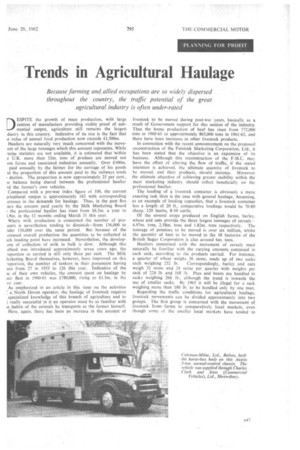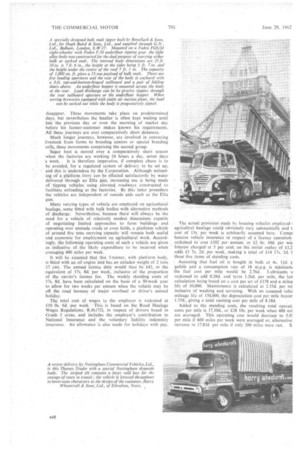Trends in Agricultural Haulage
Page 109

Page 110

If you've noticed an error in this article please click here to report it so we can fix it.
Because farming and., allied occupations are so widely dispersed throughout the country, the traffic potential of the great agricultural, industry is often under-rated
DESPITE the growth of mass production, with large centres of manufacture providing visible proof of substantial output, agriculture still remains the largest dustry in this country. Indicative of its size is the fact that Le value of annual food production now exceeds £1,500m. Hauliers are naturally very Much concerned with the movecut of the large tonnages which this amount represents. While -ecise statistics are not available, it is estimated that 'within e U.K. more than 32m, tons of produce are moved out orn farms and associated industries annually. Over .E.100m. paid annually by the firmer for the carriage of his goods id the proportion of this amount paid to the railways tends
■ decline. The proportion is now approximately 25 per cent., ie balance being shared between the professional haulier id the farmer's own vehicles.
Compared with a pre-war index figure of 100, the current ;ricultural output is approximately 183 with corresponding creases in the demands for haulage. Thus, in the past five :ars the amount paid yearly by the Milk Marketing Board , the professional haulier has risen from £6.3m. a year to .i.9m. in the 12 months ending March 31 this year.
Where milk production is concerned the number of pro„Leers is nevertheless tending to diminish—from 136,000 to rider 116,000 over the same period. But .because of the creased overall production the quantities to be collected at ich loading point have increased. Nevertheless, the developent of collection of milk in bulk is slow. Although this .ethod was introduced approximately seven years ago, the
• oportion so carried is still only three per cent. The Milk larketing Board themselves, however, have improved on this -oportion, the number of tankers in their possession having sen from 27 in 1955 to 126 this year. Indicative of the ie of their own vehicles, the amount spent on haulage by leir fleet in 1960-61 was £780,000, rising to £1.3m. in the ist year.
As emphasized in an article in this issue on the activities ' a North Devon operator, the haulage of livestock requires specialized knowledge of this branch of agriculture and to really successful in it an operator must be as familiar with ie habits of the animals he transports as the farmer himself. Here, again, there has been an increase in the amount of
livestock to be moved during post-war years, basically as a result of Government support for this section of the industry. Thus the home production of beef .has 'risen from 772,000 tons in 1960-61 to approximately 865,000 tons in 1961-62, and there have been increases in other livestock products.
In connection with the recent announcement on the proposed reconstruction of the Fatstock Marketing, Corporation, Ltd., it has been stated •that the objective is an expansion of its business. Although this reconstruction of the F.M.C. may have the effect of altering the flow of traffic, if the stated intention is achieved, the ultimate quantity of livestock to he moved, and their products, should increase. Moreover the ultimate objective of achieving greater stability within the meat marketing industry should reflect beneficially on the professional haulier,
The loading of a livestock container is obviously a more exacting task than is the case with general haulage. Assuming, as an example of loading capacities, that a livestock container has a length of 20 ft., comparative loadings would be 70-80 sheep, 120 lambs, 8-10 cattle,
Of the several crops produced on English farms, barley, wheat and oats provide the three largest tonnages of cereals4.97m, tons, 2.58m. tons and 1.82m. tons respectively. The tonnage of potatoes to be moved is over six million, whilst the quantity of beet to be moved to the 18 factories of the British Sugar Corporation is also around 6m. tons.
Hauliers concerned with the movement of cereals must naturally be familiar with the varying amounts contained in each sack, according to the products carried. For instance, a quarter of wheat weighs 36 stone, made up of two sacks
each weighing 252 lb. Correspondingly, barley and oats weigh 32 stone and 24 stone per quarter with weights per sack of 224 lb. and 168 lb, Peas and beans are handled in sacks weighing 266 lb., although the trend is towards the use of smaller sacks. By 1965 it will be illegal for a sack weighing more than 180 lb. to be handled only by one man. Regarding the traffic conditions for agrictiltural haulage, livestock movements can be divided approximately into two groups. The first group is concerned with the movement' of livestock from. farms to comparatively local markets, even though some of the smaller local markets have tended to disappear. These movements take place on predetermined days. but nevertheless the haulier is often kept waiting until .late the previous day or even the morning of market day before his farmer-customer makes known. his requirements. All these journeys are over comparatively short distances.
Much longer, journeys, however, are involved in conveying livestock from farms to breeding centres or special breeding cells, these movements comprising the second group.
Sugar beet is moved over a comparatively short season when the factories are working 24 hours a day, seven days
a week. It is therefore imperative, if complete chaos is to be avoided, for la regulated system of delivery to be set up, and this is undertaken by the Corporation. Although unloading Of a platform lOrry can be effected satisfactorily by water delivered through an Elfa gun ; increasing use is being made of tipping vehicles using elevated roadways constructed to facilitate unloading at the factories. By this latter procedure the vehicles are independent of outside aids such as the Elfa
gun. • •
Many varying types of vehicle are employed on agricultural haulage, some fitted with bulk bOdies with alternative methods of' discharge. Nevertheless: because there will -alWays he the need for a vehicle of relatively modest dimensions capable of negotiating limited . approaches to• farm' ' buildings and operating over unmade roads or even fields, a platform vehicle of around five tons carrying capacity will remain both useful and economic for employment on agricultural work. Accordingly, the following operating costs of such-a vehicle are 'given as indicative of. the likely expenditure to be incurred when
• averaging 400 miles per week.
It will be assumed that this 5-tonner, with platform body, is fitted with an oil engine and has an unladen weight Of 2 tons 17 eWt. The annual licence duty would then. be £42, or the equivalent of .17s. 8d. per week, inclusive of the proportion of the carrier's licence fee. The weekly standing costs of 17s. 8d. have been calculated on the basis of a 50-week year to allow for two weeks per annum when the vehicle may be off the road because of major overhaul or driver's annual holiday.
The, total cost of wages to the employer is reckoned at £10 Os. 6d. per week. This is based on the. Road Haulage Wages Regulations; R.H.(72), in respect of drivers based in Grade I areas, and includes the employer's contribution to National Insurance and, the voluntary liability indemnity insurance. An allowance is also made for holidays with pay. . The actual provision made by housing vehicles employed •I agricultral haulage could. obviouslyvary substantially and t cost of 13s.per .week is arbitrarily: assumed, here. Comp] hensive vehicle insurance in respect of.. a licence operaiioin reckoned to cost £102 per • annum, or £2. Os. 10d.per WCE -Interest charged' at 5 per cent: on the initial ['inlayof £1,2 -adds per, week, making 'a total of £14 17s. '2d.'t 'these five .items of standing costs. .
" Assuming that fuel oil is bought in bulk at 4s. 'gallOñ. and a consumption rate of 18 m.P.g. is maintains the fuel cost per mile would be 2.76d. Lubricants 'a reckoned to add 0.26d. and tyres 1.26d. per mile, the latl calculation being based on a cost per set of £158 and a milea life of 30,000. Maintenance is calculated at 2.35d. per mi. inclusive of washing and servicing. With an assumed vehh mileage life of 150,000, the depreciation cost per mile bedOir
1.55d„ giving a total running cost per mile of 8.18d. • •
Added to the .standing costs, the resulting total operati costs per mile is 17.10d., or £2810s. per week when 400 mil are averaged. This operating cost would decrease to 5.92 per mile if 600 miles per week were averaged or, alternative
increase to 17.83d per mile if only 200 miles were run. S.
















































































































































